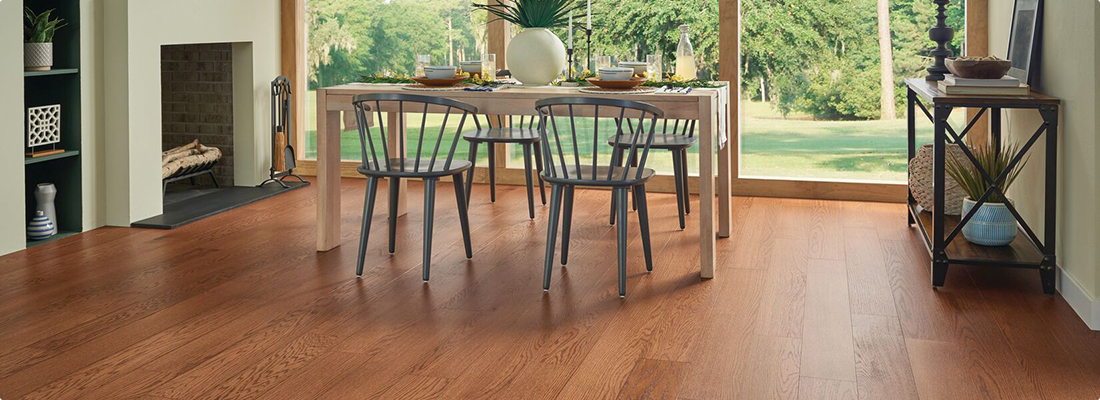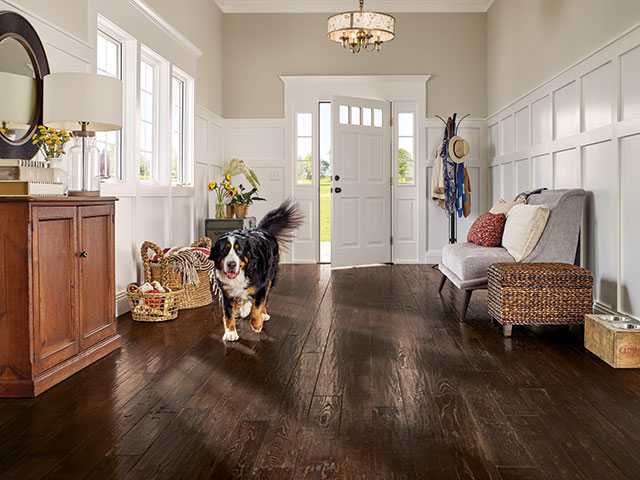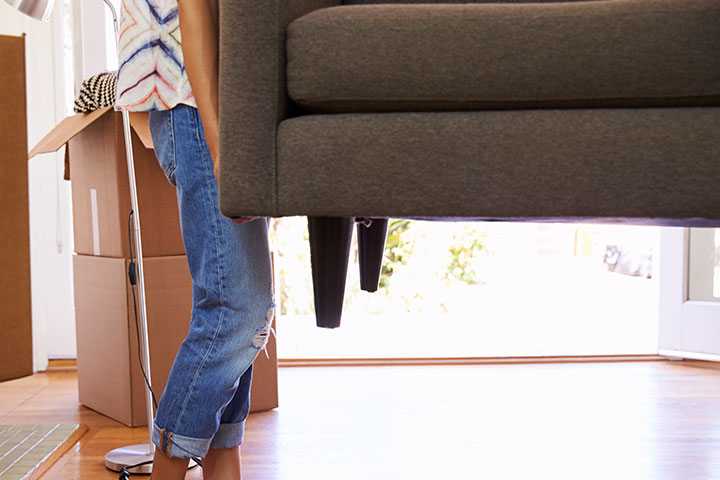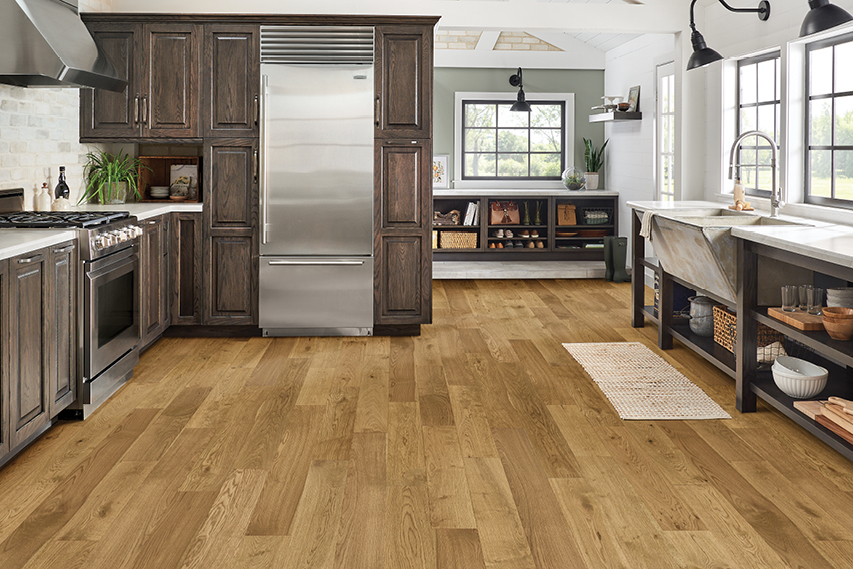Engineered Hardwood vs. Laminate
Both are great flooring options. They’re durable and can be installed anywhere in your home. So, which is the better choice for you, engineered hardwood or laminate?
Engineered Hardwood and Laminate Flooring Continue to Grow in Popularity
Solid hardwood flooring is a favorite for many homeowners. However, for some, its costs get in the way, so they begin searching for flooring that offers the character of hardwood but doesn’t hit their wallet nearly as hard. For many, that search lands them on engineered hardwood or laminate flooring.
Both options have merit. And both generate their fair share of sales in the U.S. market.
According to Business Wire, engineered hardwood enjoys a greater projected demand, with sales of $37.3 billion by 2026 at a compound annual growth rate (CAGR) of 4.6%. On the other hand, laminate flooring forecasts a $22.9 million market during that same timeframe with a 3.2% CAGR.
As with any flooring, each product has its pros and cons. In addition, everyone has a bias on which wood-look flooring option is better. So, let’s dive into the engineered hardwood vs. laminate debate to see if one flooring option makes more sense than the other.
Let’s start with a closer look at what each alternative is.
What is Engineered Hardwood?
If you’re looking for a hardwood alternative, in some ways, the debate ends here. Why? Because engineered hardwood uses hardwood on the top and bottom of the plank. So, you’re getting a hardwood floor, albeit in the form of a wood veneer that’s generally 4mm thick.
Unlike solid hardwood floors, engineered hardwood uses a plywood core that bonds to that thin hardwood layer. The advantage of that plywood core is that it offers increased moisture resistance compared to solid hardwood. So, it doesn’t flex and warp as easily.
In addition, because of that moisture resistance, you can install engineered hardwood flooring in areas where hardwood flooring presents concerns, namely basements, kitchens, bathrooms, and laundry rooms.
Apart from where you can install it, engineered flooring also has an advantage in how you install it. You must nail hardwood floors in place with a plywood subfloor. In contrast, engineered hardwood can be nailed, stapled, or glued in place. You can even install it as floating wood flooring over concrete.
The other substantial advantage of engineered hardwood is that it costs less than solid hardwood flooring. Engineered flooring typically costs $4 to $8 per square foot compared to solid hardwood, which generally runs from $8 to $15 per square foot. Plus, solid hardwood costs more to install.
You can learn more about solid hardwood vs. engineered wood here.
What is Laminate Flooring?
Like engineered hardwood, laminate is composite flooring that uses a plywood or fiberboard core layer. In addition, an underlayment is often added to the bottom of the core layer for protection and insulation.
However, unlike engineered flooring that uses a natural hardwood veneer, laminate flooring captures a wood look by gluing an image layer to the top of the core layer. That image layer incorporates a printed, high-resolution image of hardwood, stone, or other material. In addition, it adds a transparent wear layer to protect the lower layers from damage.
Generally, you install laminate flooring as a floating floor. Its interlocking planks get laid across a subfloor. And that makes laminate a breeze to install – no glue, no nails, no staples. So, if you’re a DIY enthusiast, laminate flooring presents an excellent choice.
The real kicker is cost. Compared to hardwood flooring, it’s a bargain. You’ll even pay less than you would for engineered hardwood. Laminate flooring typically costs less than $3 per square foot and even as low as $1(or less) per square foot. Installation costs are also less than engineered wood and, as mentioned, perfect for DIYers.
By now, you’ve likely gleaned that laminate flooring delivers installation and material cost advantages to engineered hardwood flooring. But what engineered hardwood vs. laminate when you consider other features?
Engineered Hardwood Tops Laminate Flooring in Appearance
This conclusion shouldn’t be too startling. After all, engineered hardwood uses that real wood veneer. So, unless you tell someone it’s engineered flooring, they’d never know it wasn’t a solid hardwood floor.
Slice it or dice however you like. For example, laminate floors don’t use natural wood. But thanks to digital photography advances, laminate floors have come a long way in capturing a real-wood look.
Laminate can mimic virtually any species of hardwood. So, it can be challenging to decipher the difference between laminate and wood flooring – until you take a close-up look.
Unfortunately, laminate floors can’t produce the same texture or feel as hardwood flooring. In addition, laminate often uses a high-gloss finish, making it look more artificial. Last, you’ll know the difference when you step on the flooring. Laminate is cushier than an engineered floor.
Engineered Hardwood Floors Offer Greater Durability Compared to Laminate
When it comes to durability, you should consider two things. First, how long will your floors last? Second, how durable are the floors?
Engineered hardwood lasts longer and holds up better than laminate flooring. For example, engineered hardwood floors generally have a lifespan of 30 years. However, some manufacturers like Hartco offer a 50-year residential limited warranty on some engineered flooring like HydroBlok™.
Beyond the 30-year lifespan, you can refinish most engineered hardwood floors once, maybe even twice. So, that extends its longevity beyond that of a laminate floor with a lifespan of 20 years.
Moreover, you can’t refinish a laminate floor. When it’s worn out, it’s worn out, and you have to replace it. It’s also more challenging to hide scratches and repair laminate than engineered hardwood.
What About High Traffic, Including Pets?
Laminate floors have gained a reputation for their toughness. The finish on its upper layer delivers exceptional scratch resistance that withstands pet nails, even rowdy kids. It also resists staining and impacts.
So naturally, from the standpoint of pet-friendly flooring, laminate trumps engineered hardwood. Right? Not so fast!
We mentioned Hartco’s HydroBlok engineered wood flooring. It provides an equally, perhaps more significant, pet-friendly flooring option vs. laminate. Consider that HydroBlok planks yield a Janka hardness of up to 2500.
In case you aren’t familiar with the Janka rating, it measures the hardness of wood. For example, hickory, generally considered one of the hardest species for wood flooring, has a Janka rating of 1820 (that means it takes 1820 lbs of force to embed a .444-inch diameter steel ball into the wood to half the ball’s diameter).
At a 2500 rating, HydroBlok engineered hardwood delivers 37% greater hardness than even hickory. As a result, it easily rivals laminate flooring for scratch and dent resistance, denting, and high traffic.
If you encounter unsightly scratches, you can clean them up with a hardwood floor touch-up pen. And remember, you can also refinish engineered hardwood. So, maybe there’s a new clear winner for pet-friendly flooring!
Engineered Flooring vs. Laminate for Water-Resistance
One point is obvious. Engineered hardwood and laminate flooring offer more substantial water resistance than solid hardwood. So, if your solid hardwood floors get wet, it may be game over.
Laminate floors use several features to repel water from the inner core, including a tight-locking tongue and groove system, advanced materials, and thick back layers. Similarly, engineered floors include features that give them water-resistant performance as well.
But here’s a game-changer. Let’s jump back to HydroBlok. It uses a three-part system that ends with a 100% waterproof engineered hardwood floor. So, you get top-down protection from water for 36 hours – guaranteed. And that’s a significant edge for engineered hardwood vs. laminate.
The flooring also includes Cleantivity™ Antimicrobial Protection. That’s a scientific way of saying HydroBlok flooring inhibits the growth of bacteria that can cause odors and mold and mildew that can damage your floors.
Which Flooring Option is the Better Investment?
We’ve already determined that laminate beats engineered hardwood based on material and installation costs. But does that make laminate a better investment than engineered flooring?
It’s well-known that solid hardwood floors increase a home’s resale value. So, it shouldn’t be surprising that engineered hardwood does the same by using an actual hardwood surface. But, equally important, it presents the same kind of longevity as hardwood flooring. And that counts with prospective buyers.
On the other hand, laminate has a lesser perceived value than hardwoods, though you can expect a better return than carpet or vinyl. However, if you elect to go with a lower-grade laminate floor, you can even drag down the value of your home.
So Which Flooring Do You Prefer, Engineered Hardwood or Laminate?
That’s the crux of the matter. It’s your home and your flooring. So, you have to decide what will work best for you and your family.
Engineered hardwood beats laminate if you want the look and feel of an actual wood floor. And with some of the advances that engineered flooring as HydroBlok delivers, it has advantages relating to waterproofing and pet-friendly flooring.
But money has a way of talking. For a wood-look floor that’s easy to install, durable, and won’t break your budget, laminate clearly has its place.
Hartco sells a variety of residential wood flooring options, including solid hardwood, engineered hardwood, and rigid core flooring that’s also waterproof.
Use our handy locator to find a wood flooring retailer near you. And don’t forget to take advantage of our floor visualizer. It lets you see our wood flooring by taking a photo of your room and selecting a Hartco flooring product.
Inspiration to Your Inbox
Sign up for news about our latest flooring innovations—and get inspired for your next project.
Sign Up

 Engineered Hardwood Flooring Pros and Cons
Engineered Hardwood Flooring Pros and Cons How to Clean Hardwood Floors
How to Clean Hardwood Floors Hardwood Flooring Installation
Hardwood Flooring Installation How Much Does Hardwood Flooring Cost?
How Much Does Hardwood Flooring Cost?